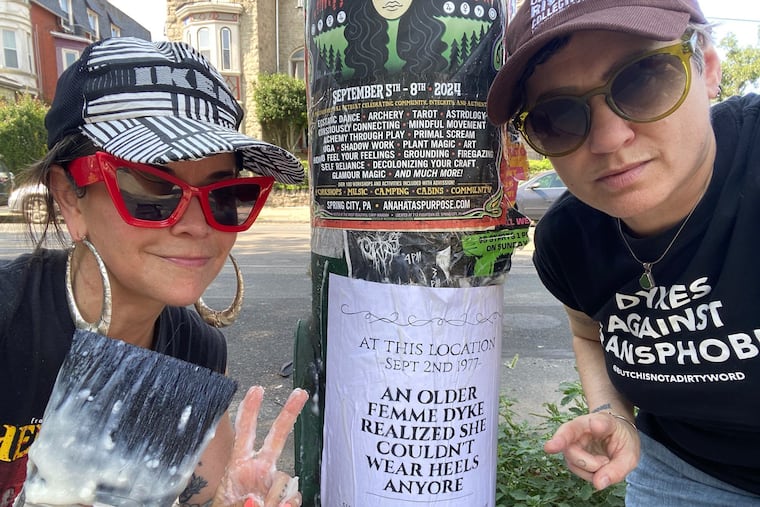Philly’s gay archives weren’t very funny. So some artists made their own.
The Lesbian Mapping Project documents not-so-historic events in Philly.

The posters began popping up on street poles and electrical boxes over the summer. In black capital letters against a white background, they displayed the solemn language of traditional historical markers: “At This Location ... It happened here.”
But the memorialized events were not exactly universally renowned. “An Older Femme Dyke Realized She Couldn’t Wear Heels Anymore. It was fine!!! She didn’t go out that much anyway,” one read. “An elder dyke spent time with a bunch of young queers. Everyone had a lot of fun,” read another.
The posters make up the Lesbian Mapping Project, a collaboration between Juno Rosenhaus, an artist and founder of Dyke+ ArtHaus in West Philadelphia, and Beth Schindler, an Austin, Texas-based artist who visited the ArtHaus for a 10-day residency this summer.
“The heart of it is about being visible, saying lesbians live here,” Rosenhaus, 62, said. “We’re part of the larger community, but we also have our own thing.”
Rosenhaus founded the Dyke+ ArtHaus, a community space for “Dyke artists of all persuasions” that is particularly focused on people over 40, in 2020. Since then, she has hosted dozens of artists in her three-story West Philadelphia house, along with pay-what-you-can residencies, gallery exhibits, and bimonthly dinners that she calls DAPR, for Dyke Artist Potluck Redux.
Schindler, 47, arrived for her ArtHaus residency in August, unsure of exactly what she would work on. But she has always liked to play with queer history in her work.
In 2019, she collaborated with a partner on a project called “Gay Dregs,” which she describes as a “tongue-in-cheek mockery of gay archives.” The concept for the show was that the artists had salvaged works from a dumpster behind the national gay archives.
“Just making fun of gay people, because everything is always so earnest, so serious, so life and death,” Schindler said. “The truth of the matter is that being gay is really ridiculous. Being gay is really fun and funny.”
When she arrived in Philly, Schindler explored the William Way Archive’s LGBT Mapping Project, which documents more than 1,000 places in the region that are significant in queer history. But she felt that the project portrayed “the classic sad trail” of hate and devastation that gay archives often highlight. (While it does mark sites of violence against the queer community, the project also records a wide range of LGBTQ history, from historic cruising spots to the homes of famous gay and lesbian Philadelphians.)
Schindler wanted her project to be lighthearted, drawing on the “life and comedy” of her community.
The first posters she made were drawn from her own experiences — “When an older femme realized that she couldn’t wear heels anymore, that’s totally me,” she said with a laugh — and those of her friends. Then she and Rosenhaus wheat-pasted them onto poles and walls in West Philadelphia and the Gayborhood. The project quickly took off, with people sharing photos of the posters online and adding their own experiences and stories. Schindler designed a dozen more.
The posters, along with blank templates, are available for anyone to print. So far, they have popped up in cities around the world, including Provincetown, Montreal, and Berlin. Schindler plans to post them in her hometown of Austin next.
“Any one of those things could have taken place on any corner in the world,” Rosenhaus said. “These are the fun and intimate real-life things that have happened to so many of us.”